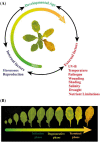Know when and how to die: gaining insights into the molecular regulation of leaf senescence
- PMID: 36389097
- PMCID: PMC9530073
- DOI: 10.1007/s12298-022-01224-1
Know when and how to die: gaining insights into the molecular regulation of leaf senescence
Abstract
Senescence is the ultimate phase in the life cycle of leaves which is crucial for recycling of nutrients to maintain plant fitness and reproductive success. The earliest visible manifestation of leaf senescence is their yellowing, which usually commences with the breakdown of chlorophyll. The degradation process involves a gradual and highly coordinated disassembly of macromolecules resulting in the accumulation of nutrients, which are subsequently mobilized from the senescing leaves to the developing organs. Leaf senescence progresses under overly tight genetic and molecular control involving a well-orchestrated and intricate network of regulators that coordinate spatio-temporally with the influence of both internal and external cues. Owing to the advancements in omics technologies, the availability of mutant resources, scalability of molecular analyses methodologies and the advanced capacity to integrate multidimensional data, our understanding of the genetic and molecular basis of leaf ageing has greatly expanded. The review provides a compilation of the multitier regulation of senescence process and the interrelation between the environment and the terminal phase of leaf development. The knowledge gained would benefit in devising the strategies for manipulation of leaf senescence process to improve crop quality and productivity.
Keywords: Crop productivity; Omics technologies; Regulation; Senescence.
© Prof. H.S. Srivastava Foundation for Science and Society 2022, Springer Nature or its licensor holds exclusive rights to this article under a publishing agreement with the author(s) or other rightsholder(s); author self-archiving of the accepted manuscript version of this article is solely governed by the terms of such publishing agreement and applicable law.
Conflict of interest statement
Conflict of interestNo competing interest.
Figures


Similar articles
-
Leaf Senescence: Systems and Dynamics Aspects.Annu Rev Plant Biol. 2019 Apr 29;70:347-376. doi: 10.1146/annurev-arplant-050718-095859. Epub 2019 Feb 27. Annu Rev Plant Biol. 2019. PMID: 30811218 Review.
-
Current Understanding of Leaf Senescence in Rice.Int J Mol Sci. 2021 Apr 26;22(9):4515. doi: 10.3390/ijms22094515. Int J Mol Sci. 2021. PMID: 33925978 Free PMC article. Review.
-
Delaying or promoting? Manipulation of leaf senescence to improve crop yield and quality.Planta. 2023 Jul 21;258(3):48. doi: 10.1007/s00425-023-04204-1. Planta. 2023. PMID: 37477756 Review.
-
New insights into the regulation of leaf senescence in Arabidopsis.J Exp Bot. 2018 Feb 12;69(4):787-799. doi: 10.1093/jxb/erx287. J Exp Bot. 2018. PMID: 28992051 Review.
-
Function of Protein Kinases in Leaf Senescence of Plants.Front Plant Sci. 2022 Apr 25;13:864215. doi: 10.3389/fpls.2022.864215. eCollection 2022. Front Plant Sci. 2022. PMID: 35548290 Free PMC article. Review.
Cited by
-
Arabidopsis GDH1 and GDH2 genes double knock-out results in a stay-green phenotype during dark-induced senescence.Physiol Mol Biol Plants. 2024 Oct;30(10):1631-1642. doi: 10.1007/s12298-024-01517-7. Epub 2024 Oct 17. Physiol Mol Biol Plants. 2024. PMID: 39506990
-
Identification and functional characterization of the MYB transcription factor GmMYBLJ in soybean leaf senescence.Front Plant Sci. 2025 Jan 24;16:1533592. doi: 10.3389/fpls.2025.1533592. eCollection 2025. Front Plant Sci. 2025. PMID: 39926644 Free PMC article.
-
Dynamic landscape of long noncoding RNAs during leaf aging in Arabidopsis.Front Plant Sci. 2022 Dec 1;13:1068163. doi: 10.3389/fpls.2022.1068163. eCollection 2022. Front Plant Sci. 2022. PMID: 36531391 Free PMC article.
-
Influence of Summer Drought on Post-Drought Resprouting and Leaf Senescence in Prunus spinosa L. Growing in a Common Garden.Plants (Basel). 2025 Apr 5;14(7):1132. doi: 10.3390/plants14071132. Plants (Basel). 2025. PMID: 40219200 Free PMC article.
References
Publication types
LinkOut - more resources
Full Text Sources
